By Frank Iannamico
The universally respected M1 Garand service rifle was designed and developed at the U.S. Springfield Armory. During World War II, the rifle was manufactured by both the Armory and Winchester. During the 1950–1953 Korean War, the M1 was placed back into production, this time by the Springfield Armory, Harrington & Richardson and International Harvester. Along with M1 rifles, World War II M1 and M2 carbines were issued to U.S. soldiers and Marines.
During the last year of World War II, the U.S. Ordnance Department set out to develop a select-fire version of the M1 rifle. The effort resulted in a long line of T-prefix (Test) rifles that ran from the T20 in 1945 to the final T44E4 rifle in 1957. During the Cold War period, the U.S. and NATO Allies anticipated that the next conflict would take place in Eastern Europe. After a long and very expensive development period, it came down to two rifles: the Belgian-designed T48 (FN FAL) and the T44E4 designed and developed at the Springfield Armory. Both weapons were chambered for the 7.62 NATO cartridge. The U.S.-designed T44E4 was chosen and adopted as the U.S. M14 rifle in May 1957; although no M14s were issued until 1959. Most of the NATO Allies chose the Belgian-designed FN FAL in various guises.
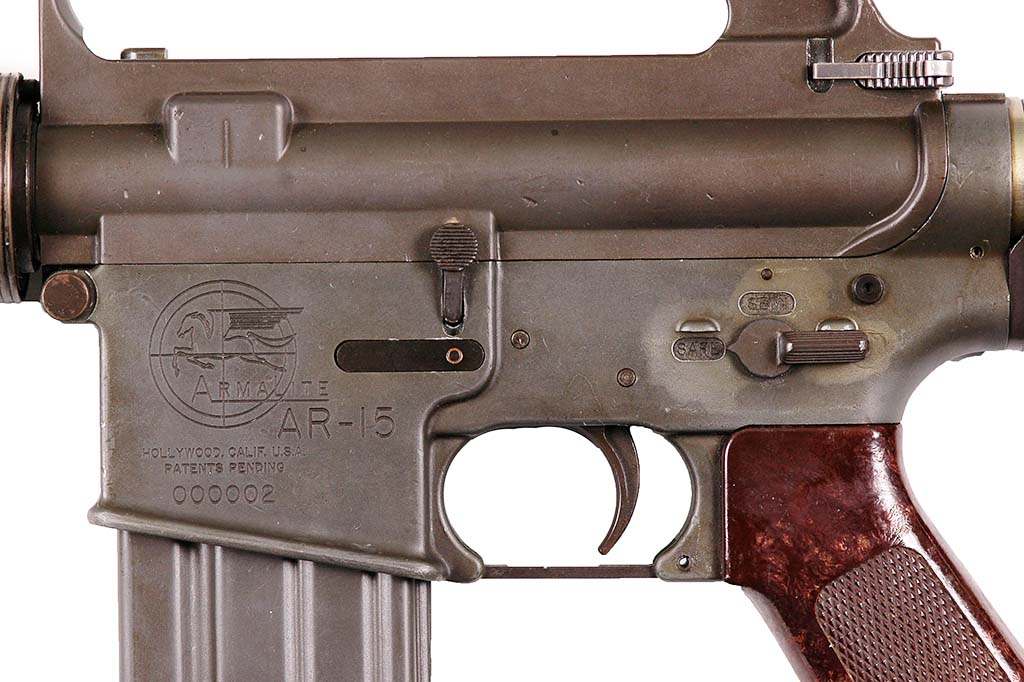
The Vietnam War
Although U.S. military advisors and Special Forces personnel were in Vietnam since the early 1960s, the first U.S. combat troops didn’t arrive in Vietnam until 1965; they were armed with M14 rifles. Early in the conflict, the enemy, primarily the Viet Cong guerillas, were armed with an assortment of World War II weapons, along with weapons abandoned by the French forces when they withdrew from Vietnam in 1954. As the war progressed, communist allies of North Vietnam, primarily China, began to equip the North Vietnamese Army and the Viet Cong with modern weapons, which included Chinese-made SKS semiautomatic rifles and select-fire, Type 56 (aka AK-47) rifles.
Soon U.S. troops discovered that the M14 was not well-suited for jungle warfare, particularly when pitted against enemy troops armed with AK rifles. Due to its powerful 7.62mm cartridge, the M14 was difficult to control during full-automatic operation; as a result, most M14s were issued with selector locks, limiting their operation to semi-automatic only. Another disadvantage of the M14 rifle was the size and weight of the 7.62x51mm round, limiting the ammunition load that could be carried. The enemy’s AK rifles had full-automatic capability, a 30-round magazine, and due to its smaller mid-range 7.62x39mm cartridge, a larger ammunition load could be carried. The enemy’s AK put the U.S. troops armed with M14 rifles at a lethal disadvantage in firefights.

As the M14 was entering into series production, ArmaLite®, a division of Fairchild Aircraft located in Southern California, was busy developing a small-caliber, select-fire rifle designated as the AR-15. ArmaLite had previously developed the AR-10 rifle chambered for the 7.62 NATO cartridge. The AR-10 was tested and rejected by the Ordnance Corps. ArmaLite had invested a lot of money and effort to market its AR-10 and AR-15 rifles but became discouraged after the U.S. adoption of the M14; the company was ready to cut its losses. On February 19, 1959, Colt® purchased the rights to the AR-10 and the AR-15 rifles; a few months later in August 1959, the first M14 rifles were delivered to the Army at Fort Benning.
The M16 had a lot of human engineering that made it user friendly. In addition to its lightweight, the fire control lever could be manipulated from safe to semi or auto with the shooter’s right thumb while keeping his hand on the pistol grip. The mag release button could be depressed by the trigger finger and the mag dropped out; a fresh magazine could be inserted straight into the magazine well without rocking, resulting in a fast magazine change. Upon emptying the magazine, the bolt catch held the bolt carrier to the rear. After inserting a new magazine, the shooter simply hit the top of the catch with his palm to release the bolt and chamber a live round. The weapon’s stock in line with the barrel reduced muzzle climb.
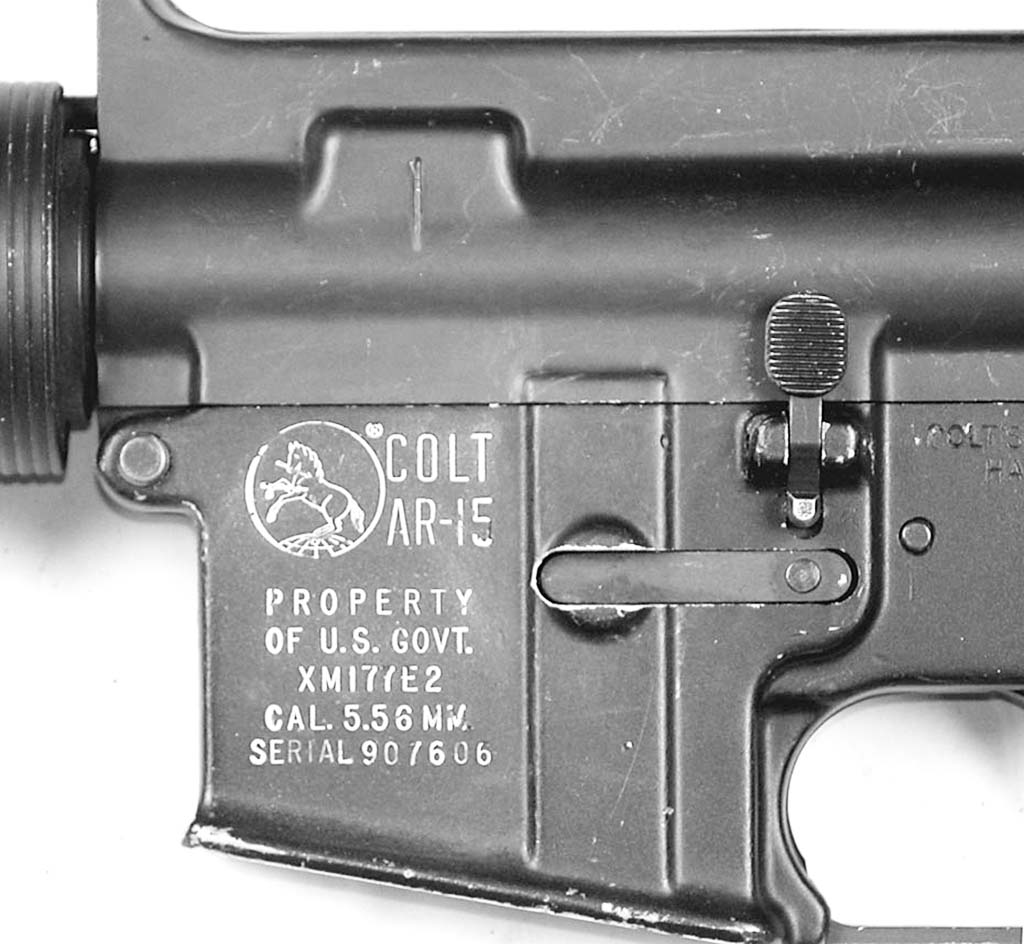
During 1961–1962, outside normal channels, a small number of AR-15 rifles were shipped to Vietnam for issue to Special Forces advisors and the South Vietnamese allies. Initial reports from the field were very favorable. Emphasis was placed on the lightweight of the weapon, controllability during full-automatic fire and its lethality. The early AR-15s shipped to Vietnam were fitted with 1:14-inch twist barrels. The 55-grain bullets were barely stabilized as they traveled to the target effecting accuracy, but upon striking the enemy, the bullets would yaw, tumble and fragment resulting in some devastating wounds.
The U.S. Air Force’s primary shoulder-fired weapons were the M1 and M2 carbines, dating back to World War II. However, the Air Force was not interested in adopting the M14 rifle. Air Force General Curtis LeMay had been introduced to the AR-15 by representatives from the Colt factory. The General felt that the lightweight AR-15 would be a suitable replacement for the old carbines. Initial Air Force requests to adopt the AR-15 were rejected, but LeMay was persistent, and finally, in May 1962 the purchase of 8,500 AR-15 rifles was approved; the price without the forward assist feature that the Air Force deemed unnecessary was $112.00 each. In addition to the Air Force, 20,000 AR-15s were procured for the Navy SEAL teams, U.S. military advisors assigned to Vietnam and the ARVN (Army of the Republic of Vietnam) soldiers.
During 1963, the U.S. ended procurement of the M14 rifle and purchased 85,000 Colt XM16E1 rifles. By 1966, an additional 400,000 XM16E1 rifles were ordered, making it the most prolific rifle issued to U.S. and South Vietnamese forces in Vietnam during that period.
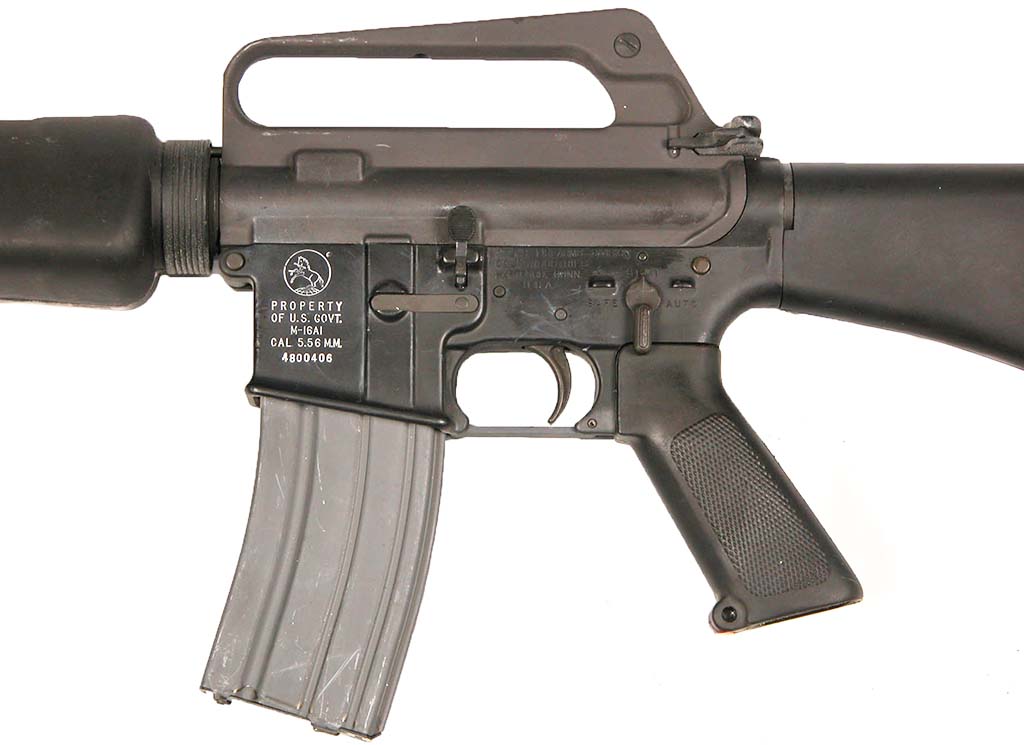
Trouble in the Jungle
As early as 1965, there were reports coming in from the field of major problems with the M16 rifle; there were several contributing factors to create a perfect storm. Many troops were trained on the M14 and had not seen an M16 until they were issued one on arrival in-country and reportedly received little or no training. Troops were basically told that the M16 rifle did not require any maintenance, and as a result, no cleaning equipment was issued. A major contributing factor was the design of the rifle and the humid climate of Vietnam. One of the most common problems was failure to extract a spent cartridge case. The cause was found out to be a combination of problems: corrosion in the barrel and chamber, lack of preventative maintenance and a change in the gun powder used to load the M193 5.56mm cartridges, which increased the cyclic rate to a dangerous level.
The problems were discovered and solved by a new buffer, chromium plating the chambers and later the bores and chambers, a stainless-steel gas tube, issue of cleaning kits and training. After the fixes were in place, the M16 became a reliable weapon. During February 1967, Colt’s XM16E1 became the “U.S. Rifle, 5.56mm, M16A1,” officially replacing the M14 as the “Standard A” infantry rifle.
Colt manufactured AR-15-M16 rifles in a large number of different configurations, far beyond the scope of this article. Most of the models presented are those used–issued to U.S. military personnel. Many of the rifles described were transitional models, and many had a mixture of updated and older features.
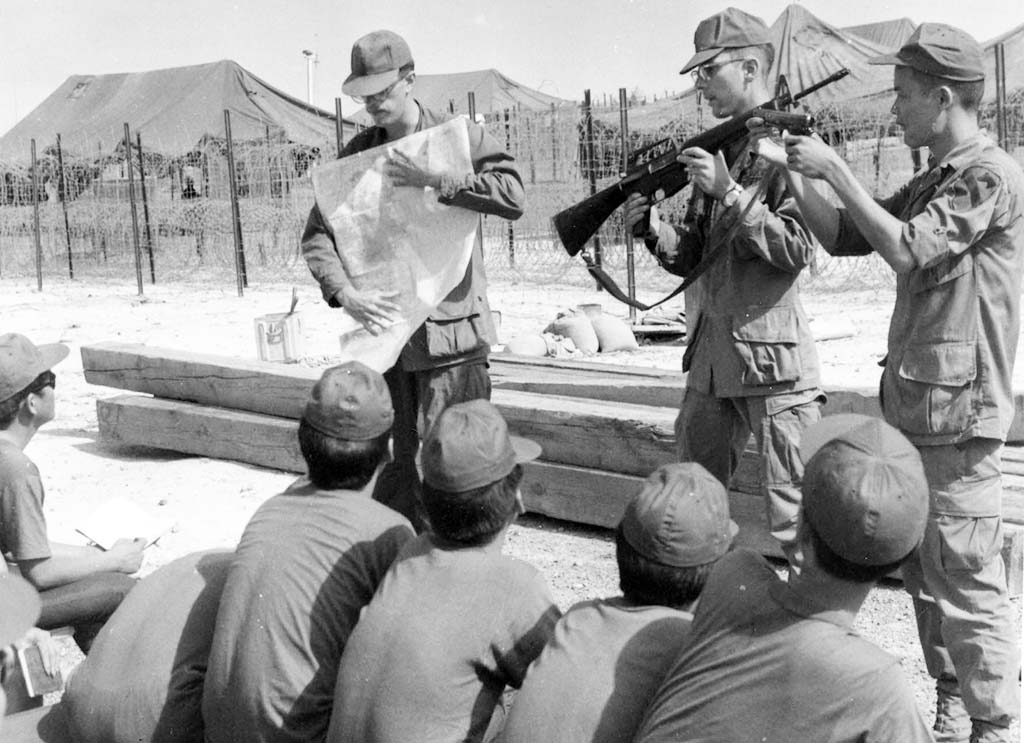
Model 601, 1959–1963
The Model 01 rifles were the first issued by the U.S. military in limited numbers with 8,500 going to the Air Force and 1,000 for evaluation in project AGILE, a study to how best support South Vietnam. The weapons had no forward assist feature but had the triangle-type charging handle, “slab side” receiver, a chromed bolt carrier and bolt, a 1:14 twist barrel, a three-prong “duckbill” flash hider, green triangle forearms and a fixed buttstock, rubber buttplate without a trapdoor. The 20-round magazines were the early steel “waffle” pattern. The receivers were marked with both the ArmaLite and Colt names. The caliber was marked .223. Some of the early models were sold overseas; two of the first customers were Malaysia and India.
Model 602, 1963–1964
The Model 02 rifle incorporated the first changes that included the second design, three-prong open flash hider and improved charging handle. Receivers were roll marked “AR-15,” some with “Property of U.S. Govt.” markings—no forward assist feature, chrome bolt carrier and bolt. The receiver had a longitudinal rib (often referred to as a partial fence) primarily used to house a spring and plunger to retain the new captive front take-down pin and a redesigned ejection port door. The barrel was updated with a 1:12 twist to increase accuracy. It had a black fixed stock with rubber buttplate, no trapdoor and triangle forearm. Approximately 19,000 of these models were procured by the U.S. military.
Model 603, 1964 / 1967 / 1983
The Model 603 rifle was the commonly issued XM16E1 of 1964, with many transitional features evolving into the final M16A1 model during 1967 that solved most of the issues with the M14. The first production model was fitted with the forward assist feature and originally configured with the second design, prong-type flash hider, and later adopted the closed-end “bird cage” type. The rubber buttplate was later replaced by a buttstock and trap door to house a cleaning kit, the rear sling swivel was now fixed in place. A new buffer was designed and implemented. Early rifles had the partial “fence” on the right side of the magazine housing; newer models had the full “fence” to prevent accidental ejection of the magazine. Barrel chambers were chromium-plated to resist corrosion; later both the chambers and bores were chromium-plated. The internal surfaces of the bolt carrier and carrier key were also chromium-plated; outside surfaces of bolt and bolt carrier were parkerized. The firing pin was redesigned to prevent slam-fires. Magazine housings were “AR-15 / M16 Property of U.S. Govt.” marked. A 30-round magazine was introduced during 1969. To keep up with the demand for M16A1 rifles, in 1968 the initial second and third source contracts were awarded to the Hydramatic Division of General Motors and Harrington and Richardson Arms Inc. The M16A1 remained in service with the U.S. until gradually being phased out by the M16A2 rifle, adopted by the U.S. Marines in 1983 and the Army during 1986.
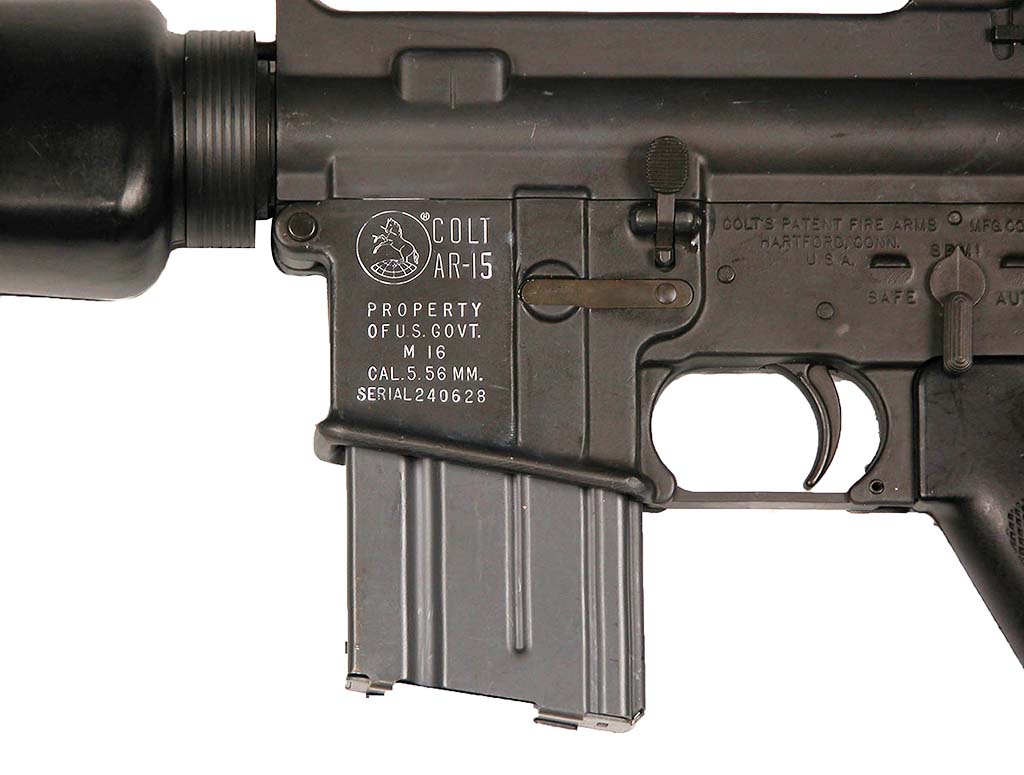
U.S. Air Force Colt Model 604 “Property of U.S. Govt. AR-15/M16” marked. The Air Force model did not have the forward assist feature.
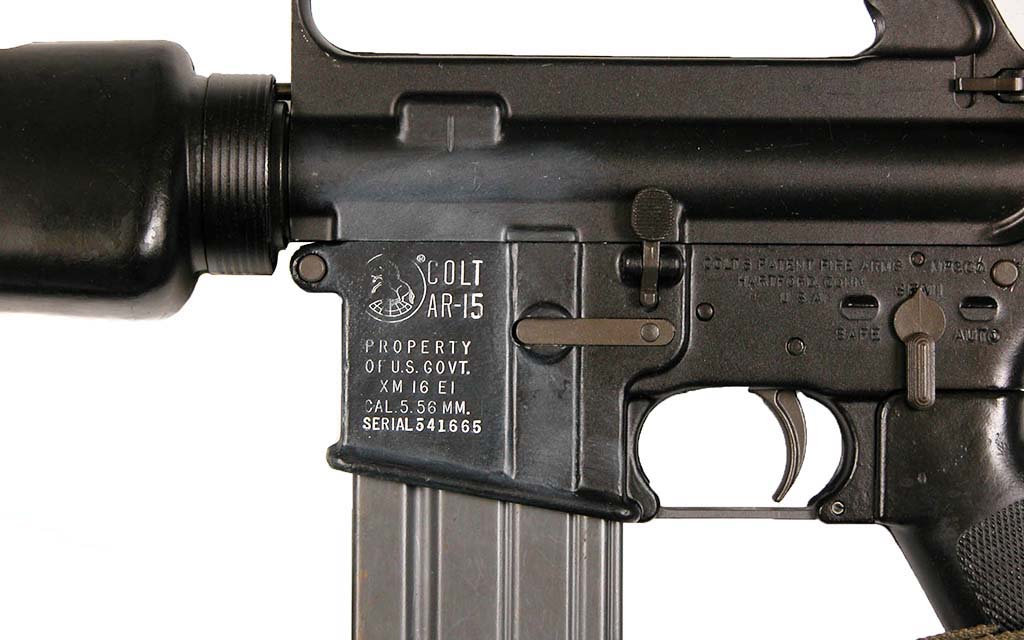
The XM16E1 was first procured in 1964; there were a number of changes implemented in the design to improve its reliability before evolving into the final M16A1 rifle in 1967.
Model 604
This rifle was the primary model adopted by the U.S. Air Force without the forward assist feature. Early models had chrome-plated bolt carriers and bolts without the serrations used for forward-assist-equipped rifles. To simplify the supply system later, Air Force rifles had bolt carriers with the serrations and three-prong flash hiders; later models had the “bird cage” type. “AR-15 / M16 Property of U.S. Govt.” marked.
Model 609
Model 609 was the short-barrel version of the M16 rifle designated as the XM177 with a 10-inch barrel and a moderator approximately 4 inches in length to reduce noise and muzzle flash from the short barrel—no bayonet lug, no forward assist, aluminum telescoping two-position buttstock. The XM177E1 was similar with the forward assist feature. The XM177E2 was the same as the E1 model but had a longer 11.5-inch barrel.
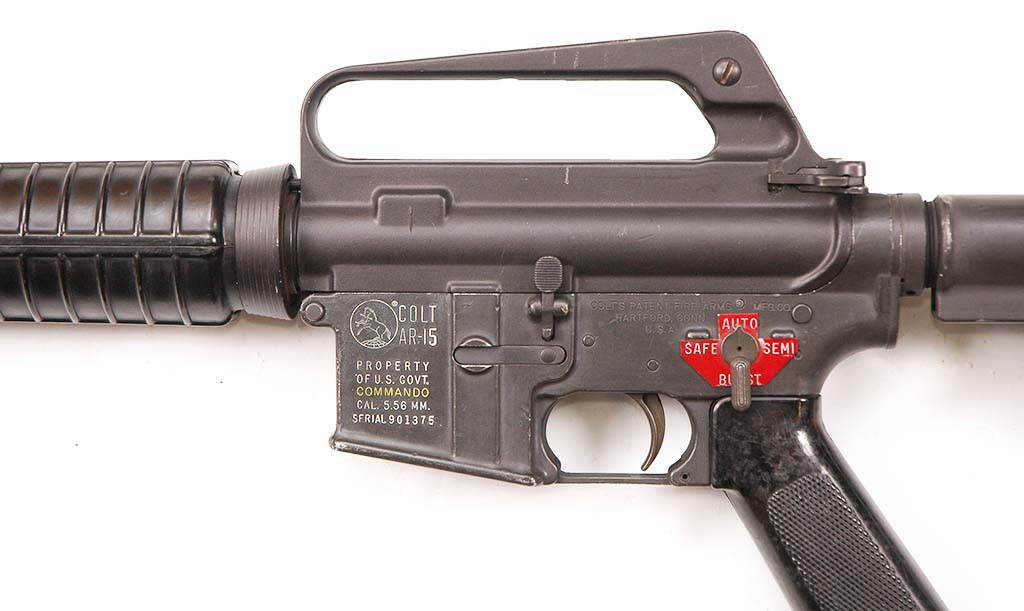
Model 613
The Model 613 was the commercial export and police model of the M16A1 with the forward assist feature. Receivers were marked “M16A1.”
Model 614
Model 614 was the commercial export and police model of the M16A1 without the forward assist feature. Receivers were marked “AR-15.”
Model 619
Commercial export and police model of the XM177E1 Commando with a 10-inch barrel with a moderator, telescoping buttstock and forward assist.
Model 639
Commercial export and police model of the XM177E2 Commando with an 11.5-inch barrel, moderator, telescoping buttstock and forward assist.

The adoption of the AR-15 rifle and its small caliber cartridge met with strong opposition from the United States’ entrenched Ordnance organization, which did not want to accept a weapon designed by private industry. Other objections by military traditionalists were raised because of the AR-15’s unconventional appearance and construction of aluminum and plastic, which in their opinion did not look like a military weapon. Last was the .223/5.56mm cartridge, considered a step down from the tried and true .30-caliber standard.
After an uncertain start, the AR-15/M16 has had the longest service life of any other U.S. infantry rifle. It is still the same basic weapon issued today as the U.S. M4 carbine. The war in Vietnam saved the AR-15/M16 rifle, and possibly Colt, from extinction. If the United States had not gotten involved in the Vietnam War, the U.S. M14 rifle would have probably remained in production and the Standard “A” infantry rifle for many years; the AR-15 rifle would been forgotten and become simply a footnote in ordnance history. Today, the basic AR-15 design not only continues in service with the military of the U.S. and many foreign nations, it has arguably become the most popular civilian rifle, albeit in semi-automatic-only form, in the U.S. The AR-15-type rifles are now available from a very large number of manufacturers in a seemingly endless number of configurations and calibers, many hardly recognizable from the original rifle first introduced over 60 years ago.
Recommended Reading
The Black Rifle, Volume I by Christopher R. Bartocci, R. Blake Stevens and Edward C. Ezell
The U.S. M14 Rifle: The Last Steel Warrior, Second Edition by Frank Iannamico
| This article first appeared in Small Arms Review V25N2 (February 2021) |












